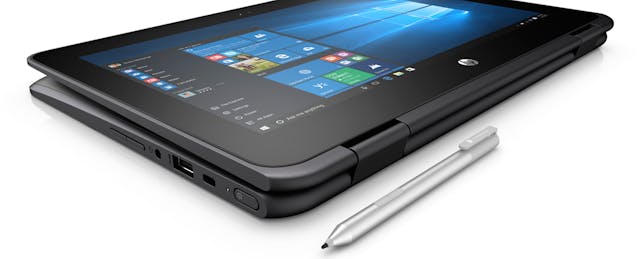In recent years Google’s offerings—in particular, Chromebooks—have captured plenty of media attention and domestic market share. Futuresource, a market research firm, estimated that Chromebooks accounted for more than half the U.S. education sales in the first quarter of 2016.
The same source estimates that Windows machines accounted for less than 25 percent in the same timeframe. But that number could change. At BETT, a major edtech expo outside of London, Microsoft is taking square aim at Google with a slew of updates to its education products.
The Redmond, Wash.-based company is attempting to make a comeback on multiple fronts, starting with software. A major feature in today’s announcement is Intune for Education, a cloud-based system management tool that offers educators 150 different settings to customize apps, browsers, start menus and privacy tools. Microsoft boasts that these settings can be applied to one student or synchronized across entire districts in a matter of minutes. Intune can also sync with other Microsoft tools like Office 365 Education and Schools Data Sync, a program that allows teachers to create groups based on roster data that can be configured for a plethora of education apps.
In addition, Microsoft plans to release a fleet of low-cost Windows 10 devices aimed at the education market. Like Google, Microsoft is working with companies like HP, Acer, and Lenovo to create affordable computers for students. However, Microsoft’s PCs boast longer battery life, some up to 13 hours, guaranteeing students the ability to make it through the school day. The Lenovo N24 is designed with pen support so that students can take digitized notes by hand. All these devices run for under $300 a piece, with some as low as $189 each, a price that schools who struggle with technology funding might find appealing.
Emerging markets might be where Microsoft finds its stride. One device that it is marketing specifically for these regions is JP.IK’s TURN T201 PC, which includes a retractable handle, a thermal probe that detects temperature changes and microlenses that work as microscopes—adding science-centered functionality to the notebooks. With strong international brand recognition, Microsoft sees plenty of opportunities to capture these markets. In an interview, Jay Paulus, senior director of Windows Education Marketing expressed that desire saying, “We estimate that in the world there are 1.4 billion students and a very low percentage of those students actually have access to technology on a regular basis. So I think there is a big an opportunity to get that right technology into the hands of students in a time that it can make the biggest difference.”
In addition to management tools and devices, Microsoft also announced updates to their popular education gaming platform, Minecraft for Education—a platform the company says is used by more than 75,000 students in over 100 countries. The updates include new text-to-speech functions, a more intuitive user interface, the addition of 60 Minecraft Mentors to help educators navigate through the game, and a simpler storage method for world’s teachers create. To keep students on task, teachers now have more control of the gaming experience with the Global Pause button, allowing them to stop the game on all classroom devices as they transition to other activities.
There is no hiding Microsoft’s desire to capture Google’s market share as their press release specifically sells the new devices as “Great alternatives to Chromebooks.” Google isn’t staying put, though: the company announced its own updates to its education offerings on the same day.
However, Microsoft claims its goals go beyond simply offering a Chromebook alternative. Josh Hutto, senior director, Education Product Marketing and Marketing Communications at Microsoft, says the company’s real goal is “to help every student on the planet achieve more.”
“What I am excited about is seeing the competition bring technology into the classroom. The more kids who are able to get access to it one way or the other—that’s good for everybody,” Hutto adds. Describing competition as a “win-win” scenario for kids, his attitude marks a departure from the company’s earlier days, when it attempted to dominate the personal computing market.


